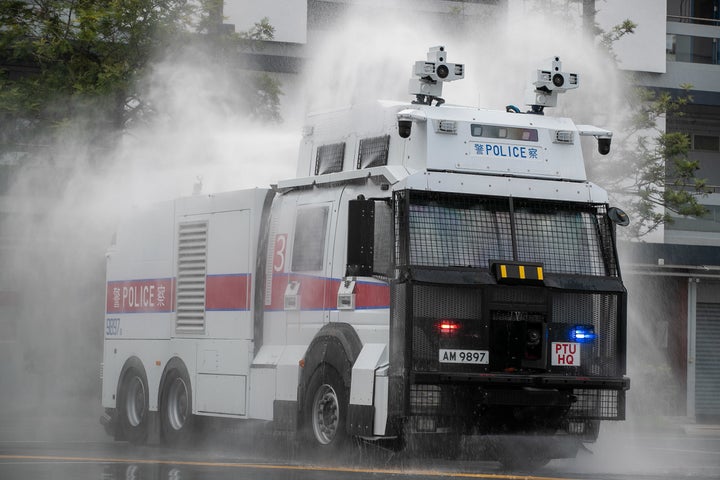A city on the “path of no return”, streets consumed by “terrorism” and an “existential threat” posed to law-abiding citizens – this is the Hong Kong protests according to the people in the sights of those protesting.
The demonstrations have rocked the city for months and the latest signs all point to escalation, rather than dying down.
In the clearest sign yet of how China views the turmoil, paramilitary police are assembling across the border in the city of Shenzhen for exercises in what some saw as a threat to increase force brought against the mostly young protesters who have turned out in their thousands over the past 10 weeks.
Why are people demonstrating?
Protestors have been demanding that Hong Kong leader Carrie Lam step down and entirely scrap legislation that could have seen criminal suspects sent to mainland China to face torture and unfair or politically charged trials.
Demonstrators say they are fighting the erosion of the “one country, two systems” arrangement enshrining some autonomy for Hong Kong when China took it back from Britain in 1997.
They want Lam to resign. She has said she will stay.
What are the protestors doing?
For weeks now the demonstrations have been on the streets of Hong Kong where protestors have squared up against police in surreal scenes choked by tear gas an illuminated by lasers, deployed in a bid to confuse and distract security services.
On Monday the protests escalated dramatically when thousands of people closed down Hong Kong airport, one of the busiest in the world.
The feat was repeated on Tuesday and a video posted to social media by freelance journalist Laurel Chor, captured the cheers as the announcement was made over the airport’s tannoy.
“Sorry for the inconvenience, we are fighting for the future of our home,” read a banner held by some of the hundreds of protesters who had returned to the arrivals hall.
While the protest at the airport was peaceful, out on the streets the incidents of violence have become more frequent.
During the weekend protests, website Hong Kong Free Press showed footage of one arrest that appeared to include officers in plain clothes pinning a demonstrator pressed to the ground.
The young man, who said his name was Chow Ka-lok and asked for a lawyer, was shown with a bleeding head wound and said he had a broken tooth, the Press Association reports.
Police have also reported injuries among their ranks, including eye irritation from laser pointers, burns from petrol bombs and bruises and cuts from flying.
Protesters hurled bricks at officers and ignored warnings to leave before tear gas was deployed in the Sham Shui Po area, police said, calling a march there an “unauthorised assembly”.
Tear gas was also deployed in central Hong Kong on both sides of Victoria Harbour, in the Tsim Sha Tsui area on the Kowloon side and in Wan Chai on Hong Kong Island.
How has the Hong Kong authorities responded?
Lam held a press conference on Monday – at a government headquarters complex fortified with six-foot high water-filled barricades.
Despite calls for her to step down, Lam was defiant. “My responsibility goes beyond this particular range of protest,” she said, adding that violence had pushed the territory into a state of “panic and chaos”.
“Take a minute to look at our city, our home. Can we bear to push it into the abyss and see it smashed to pieces?”
More ominously, Hong Kong authorities have publicly demonstrated water cannon.

What role is China playing in all this?
The legislation Lam is being pilloried over stems from the Chinese communist government and questions have been raised over whether she even has the power to rescind the bill.
During yesterday’s press conference, a reporter from Reuters repeatedly asked her if she was in fact in control. An obviously irate Lam refused to answer and said repeatedly she had already addressed the issue, despite no record of her doing so.
In China, authorities appear to be preparing for an escalation of the clampdown on the protestors.
A senior Chinese official said “sprouts of terrorism” were emerging in Hong Kong, given instances of violent attacks against police officers and legal experts say Beijing might be paving the way to use anti-terror laws to restrain the protesters.
Beijing tends to define terrorism broadly, including nonviolent movements opposing government policies on the environment or Tibet.
And on Monday, footage obtained by the state-run People’s Daily newspaper broadcast footage of a huge build-up of armoured vehicles massing for a purported drill in Shenzen, just over the border from Hong Kong.
The move is seen as a barely concealed threat to increase force brought against the mostly young protesters who have turned out in their thousands over the past 10 weeks.